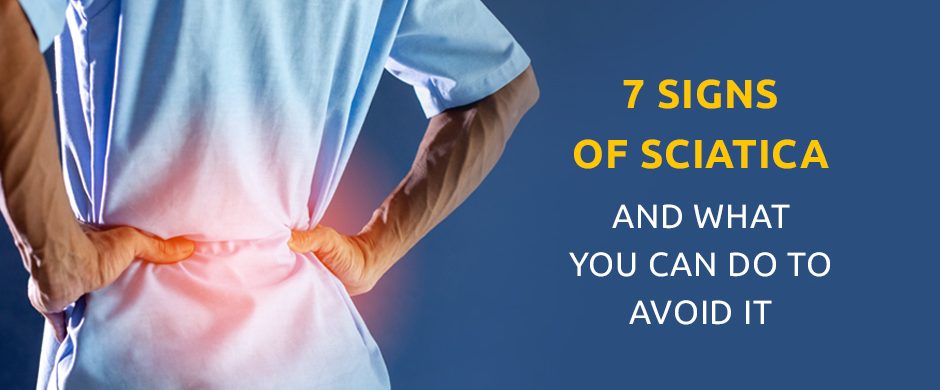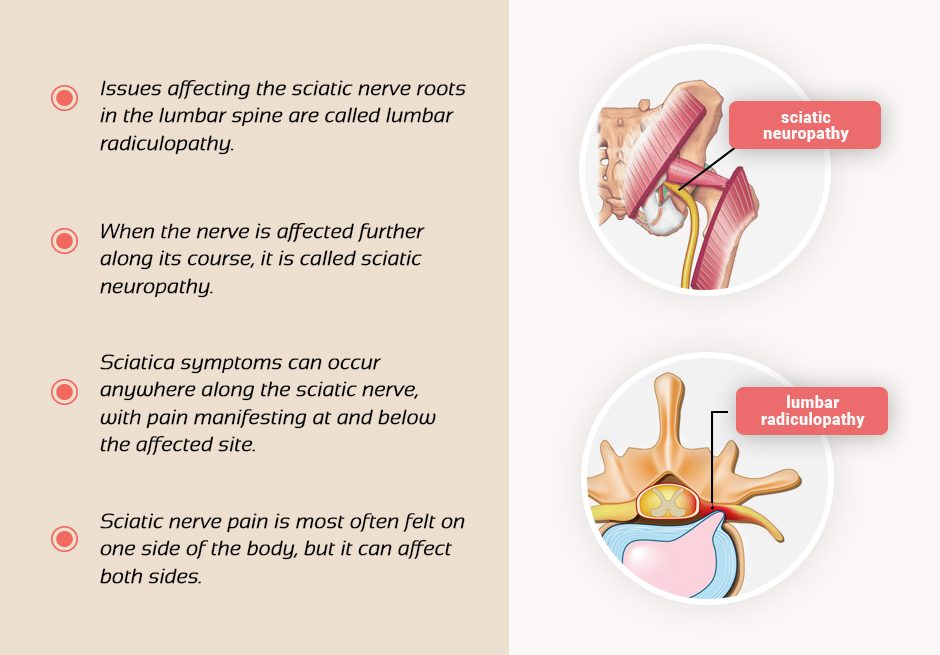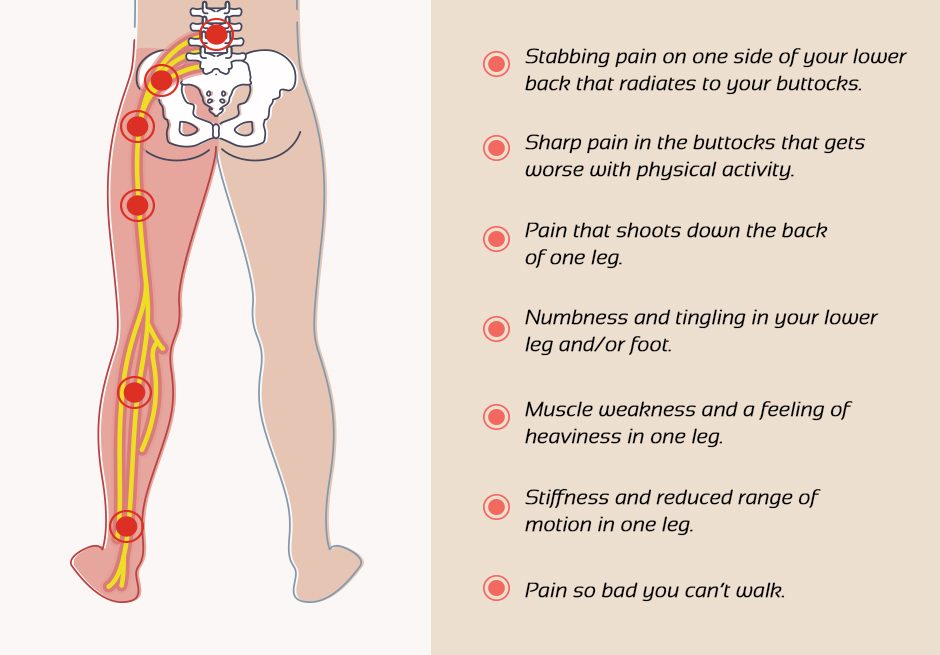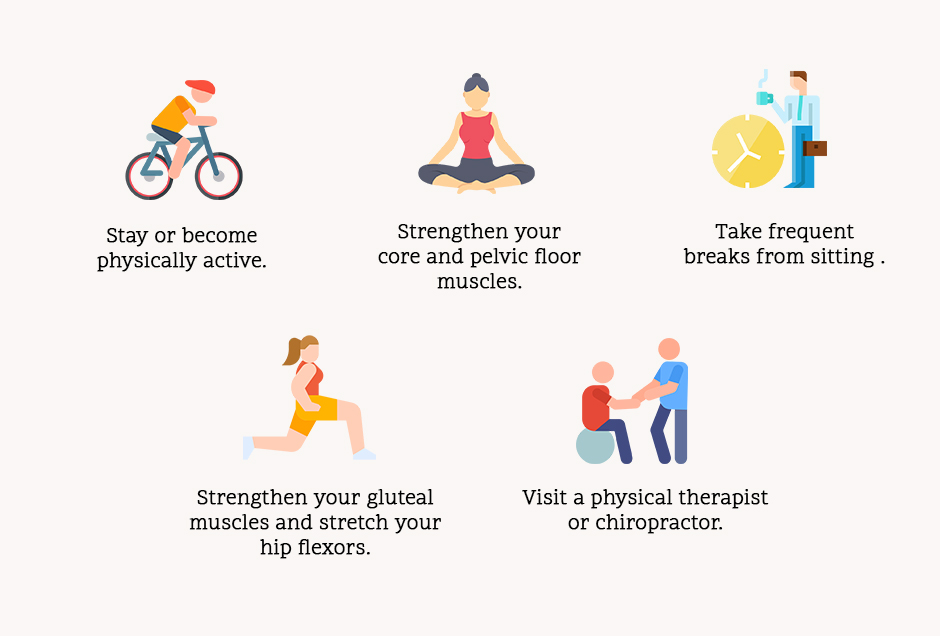
Sciatic nerve pain is common, especially today when Americans spend more time than ever sitting for extended periods without adequate exercise. The sciatic nerve is the longest and thickest nerve in your body, and it can be affected anywhere along its path, from its roots in your lumbar spine to the bottoms of your feet.
Because of the length of its pathway and the multiple structures that surround your sciatic nerve, sciatica can manifest in a variety of ways, and many other conditions can share similar symptoms. Accurate diagnosis is key to getting effective treatment, to eliminate sciatica symptoms and restore pain-free movement. Learn more.
Understanding more about your sciatic nerve and the ways it can be affected will help you identify sciatica in its early stages, and give you insight on how to avoid it.
The sciatic nerve is:
Protected by deep muscle tissues of the buttocks and legs, and cannot be palpated (felt) beneath the skin with your fingers.
As large in diameter as an adult thumb
Made up of both motor and sensory nerve cells, to send and receive messages between the brain and lower extremities.
Long and thick, and it needs to be able to glide freely between muscles, bones and connective tissues while the body is in motion.
Subject to entrapment or compression by other structures, anywhere along its path, causing pain and inhibiting free movement.
Responsible for innervating most of the muscles in your lower extremities, making it possible to walk, run and jump, and to stabilize the body while standing.

More sciatica facts:
Issues affecting the sciatic nerve roots in the lumbar spine are called lumbar radiculopathy.
When the nerve is affected further along its course, it is called sciatic neuropathy.
Sciatica symptoms can occur anywhere along the sciatic nerve, with pain manifesting at and below the affected site.
Sciatic nerve pain is most often felt on one side of the body, but it can affect both sides.
Sciatica can range from mild discomfort to pain so bad you can’t walk. Seven of the most common sciatica signs include:
Stabbing pain on one side of your lower back that radiates to your buttocks.
Sharp pain in the buttocks that gets worse with physical activity.
Pain that shoots down the back of one leg.
Numbness and tingling in your lower leg and/or foot.
Muscle weakness and a feeling of heaviness in one leg.
Stiffness and reduced range of motion in one leg.
Pain so bad you can’t walk.

Anyone can suffer from sciatic nerve pain, but being sedentary, sitting for extended periods, or driving for long hours are chief contributors.
To reduce your risk of sciatica, follow these tips:
Stay or become physically active. Simply walking on a daily basis can help your sciatic nerve glide freely and avoid entrapment.
Strengthen your core and pelvic floor muscles. Your muscles protect your sciatic nerve from becoming entrapped or compressed by bony structures and taut connective tissues.
Take frequent breaks from sitting throughout the day to move around and stretch.
Strengthen your gluteal muscles and stretch your hip flexors to restore and maintain neutral pelvic alignment.
Visit a physical therapist or chiropractor for posture assessment and correction.

Sciatic nerve pain often resolves itself over time, but if you’re struggling to walk with sciatica, try this one movement for instant sciatica pain relief, and for promoting smooth gliding of the sciatic nerve:
Lie supine on the floor with your knees bent
Slowly straighten the unaffected leg
Clasp your hands behind and above the knee of your affected leg and bring your thigh perpendicular to the floor
Flex your ankle and slowly extend your knee, stopping just before you feel tension in the hamstring
Perform 20 ankle circles inward, and 20 outward
Bend and extend your knee 20 times, being careful to not stretch your hamstring
Return to your start position
Repeat periodically throughout the day to keep your sciatic nerve gliding without inhibition from other structures.
Sciatic nerve pain can occur anywhere along the nerve’s path, and symptoms can vary. The sciatica specialists at NYDNRehab use high resolution diagnostic ultrasound to view the entire length of the sciatic nerve in real time, with the patient in motion. Ultrasound lets us identify the exact point at which the nerve is affected, so we can make informed decisions about the best course of treatment.
In addition to on-site diagnostic ultrasound imaging, the clinic at NYDNRehab features a broad range of high-tech treatment options that are rarely found in average physical therapy clinics. We provide our patients with the most accurate diagnosis and the most expeditious treatment protocols in NYC. Our personalized one-on-one approach to patient care makes NYDNRehab stand out as the best clinic for sciatica treatment in NYC.
Dr. Lev Kalika is a world-recognized expert in musculoskeletal medicine. with 20+ years of clinical experience in diagnostic musculoskeletal ultrasonography, rehabilitative sports medicine and conservative orthopedics. In addition to operating his clinical practice in Manhattan, he regularly publishes peer-reviewed research on ultrasound-guided therapies and procedures. He serves as a peer reviewer for Springer Nature.
Dr. Kalika is an esteemed member of multiple professional organizations, including: